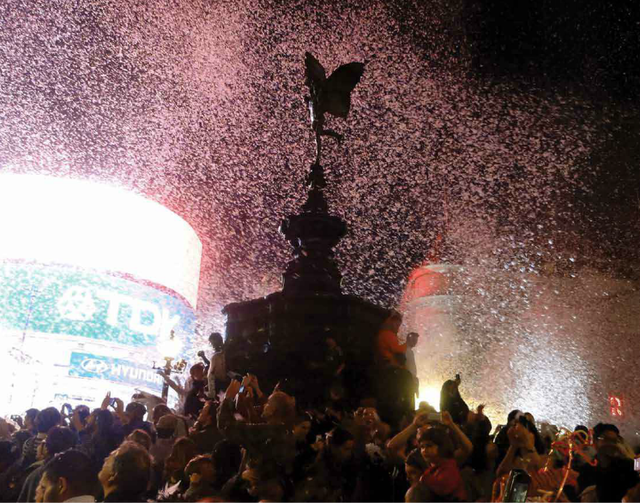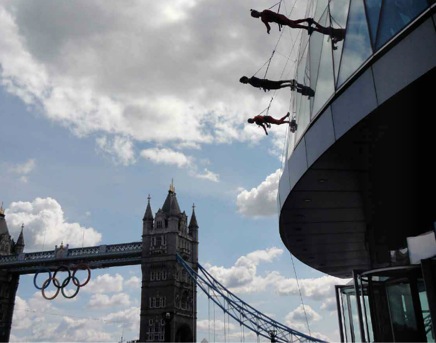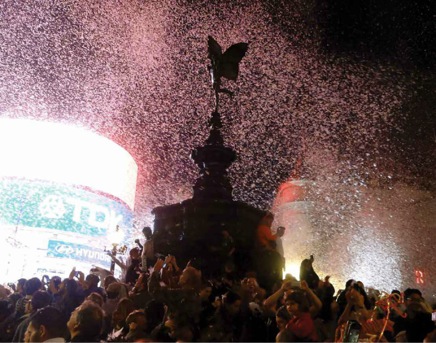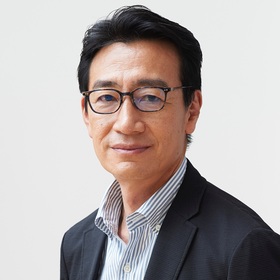Bringing Cultural Festivals to the Tokyo 2020 Olympic & Paralympic Games:

The Year 2020, Raising Expectations for Economic Growth
It has been decided that the Olympic and Paralympic Games will be held in Tokyo in 2020. Will they bring new vitality to Japan, which has been stalled with no way out for a long time? Expectations to that effect have been increasing on all sides.
In June, 2013, the bid committee announced the results of their preliminary calculations: an economic ripple effect of 3 trillion yen, and employment creation for 150,000 people. Now that results of the bidding have been decided, estimates of private research institutions show far higher figures. The economic effects of holding the Olympic and Paralympic Games span quite a wide range of industries, including, but not limited to, the development of facilities such as stadiums and athlete villages, as well as urban infrastructure, amplification of consumer spending accompanying the hosting of the Olympics and Paralympics, and an increase in travelers from overseas.
For the 1964 Olympics, Tokyo completely changed the framework of the city. Considering the capital that was invested into improving the grounds and transportation infrastructure, investments including hosting expenses and related industries, as well as consumer spending induced by hosting the Olympics, the previous Tokyo Olympic Games also brought about an immense economic effect.
After that, Japan achieved a level of economic growth so high, it surprised the world. Though we cannot say that that was a direct result of the Olympics, there is no mistaking that social capital such as the Tokaido Shinkansen, which was established with the goal of opening for business on October 1st, 1964, just before the opening ceremonies, as well as the Shuto Expressway, which had been rapidly completed around that time, supported Japan’s economic development thereafter. Then came one great event that would provide the opportunity for dreams of joining the throng of advanced nations, and momentum towards that end, to spring forth, the Japanese people to share that goal, and to push forward towards economic development – the 1964 Tokyo Olympics. If we go so far as to include it, the economic effects are immeasurable. It could be said that the economic development that followed is the previous Olympics’ greatest legacy.
There is no doubt that the 2020 Olympics will also bring about a similar economic effect. However, with its declining population and rapidly aging society, for Japan to expect the same high level of growth as it had in the last century as a result of the Olympics would be off-base.
Rather, perhaps the upcoming Olympics will bring us something even harder to come by than economic effect. In that case, what I’d like to pay attention to is cultural programs held alongside sporting events.
The Olympics and Cultural Programs
Though it is not generally known, the Olympics involve not just sports, but also cultural celebration . In the Olympic Charter (2011 edition), the first Fundamental Principle of Olympism clearly states that “Olympism is a philosophy of life, exalting and combining in a balanced whole the qualities of body, will and mind. Blending sport with culture and education, Olympism seeks to create a way of life based on the joy of effort, the educational value of good example, social responsibility and respect for universal fundamental ethical principles.”
Further, in Chapter 5, The Olympic Games, Article 39 states: “The OCOG (Organising Committees for the Olympic Games) shall organise a programme of cultural events which must cover at least the entire period during which the Olympic Village is open. Such programme shall be submitted to the IOC Executive Board for its prior approval.”
In fact, various cultural projects have been carried out in the past as well. There were no cultural programs from the Athens Games in 1896 to the London Games in 1906, but art competitions were introduced as official events from the 1912 Stockholm Games onward. Artworks based on sports as a motif competed against each other, and medals were also awarded. Then, since the 1952 Helsinki Games, art was removed from the competitions, and art exhibitions came to be held in their place.
In the 1964 Tokyo Games, based on the fundamental policy of “exhibiting the highest level of Japanese art”, rather than work based on sports motifs, the organizing committee coordinated and held exhibitions in four arts categories (Old Art, Modern Art, Photography, and Philately (stamps)), and six performance categories (Kabuki, Bunraku, Court Music, Noh, Traditional Dance and Japanese Music, and Folk-lore Entertainment). At the Tokyo National Museum, the “Old Art Treasures” exhibition was held, displaying approximately 870 pieces, including 148 national treasures such as the Scrolls of Frolicking Animals and The Tale of Genji Scroll. About 400,000 people were in attendance. [*1]
Then, a variety of cultural programs came to be implemented, in the form of the Cultural Olympiad, for four years starting from the 1992 Barcelona Games.
However, it was the London Games, of the year before last, which strengthened its cultural program from the ground up, returning to International Olympic Committee founder, Pierre de Coubertin’s ideal: “The Olympics is the wedding of sport and art.” In truth, the program was unprecedented in both scale and substance.
London’s Cultural Olympiad of Unprecedented Scale
For London 2012, the Cultural Olympiad was held over four years, beginning from the close of the Beijing Olympics. As its finale in 2012, the London 2012 Festival, a large-scale art festival, was held for two and a half months, from one month before the opening of the Olympic Games to the end of the Paralympic Games. Both the Cultural Olympiad and the Festival were held throughout the country, and 43.4 million people were said to have participated.[*2]
Overview of the London 2012 Cultural Olympiad
| Duration |
September 2008 – September 2012 (London 2012 Festival: June 21 – September 9, 2012) |
|---|---|
| Number of Participants |
43.4 million people (of which 39.8 million were participants of free events, and 25.8 million participated outside London) |
| Total Budget | 126.6 million pounds (approx. 21 trillion yen) |
| Total Number of Activities | 117,717 activities (of which 33,631 were part of the London 2012 Festival) |
| Total Number of Artists | 40,464 participants, from the same 204 countries and territories as athletes (including 25,000 London 2012 Festival artists, 6,160 up-and-emerging artists, and 806 artists with disabilities) |
| Commissions for New Work |
5,370 pieces (including 2,127 London 2012 Festival pieces) |
| Venue | More than 1,000 locations throughout the UK |
| Media Exposure | 165 hours of BBC broadcasts, coverage from 5,700 newspapers within the UK, 364 instances of overseas media coverage from 38 countries |
Source: Arts Council England and LOCOG, Reflections on the Cultural Olympiad and London 2012 Festival, April 2013

Streb Extreme Action
City Hall, London
London International Festival of Theatre
© Justine Simons
At the London 2012 Festival, large-scale experimental planning was carried out in unexpected places, free for anyone to participate in. Such extensive outdoor events were held not only in central London, but also in small country towns.
For example, in Martin Creed’s “Work No. 1197: All the bells in a country rung as quickly and as loudly as possible for three minutes”, along with the bells of Big Ben and the Parliaments of Scotland, Wales, and Northern Ireland, 2.9 million people all over the UK rang bells to their hearts’ content, celebrating the opening of the Olympic Games. 68,000 downloaded Creed’s own official London Olympics app Ringtone and participated by playing it.
Set in London’s busiest junction, Piccadilly Circus, “Piccadilly Circus Circus” was an artistic performance, with more than 240 circus artists from 17 countries, including trapeze artists, jugglers, hula hoopers, tightrope walkers, and clowns. It is said that to make it happen, the city of London closed the roads there for the first time since 1945.
An international theater festival was also held, in which theatrical companies from 37 countries consecutively performed the works of Shakespeare in 37 different languages. Over four years, over 40,000 artists from the same 204 countries as the Olympic athletes participated. Including the world premiere, new work was commissioned on a scale unprecedented to that point.
Meanwhile, a program called UNLIMITED was carried out in keeping with the spirit of the Paralympics. 29 works were commissioned to artists with disabilities and related arts organizations – these works by people with disabilities, whose limitless potential can be seen in the art world just as it can in sports, were appreciated.
Then, 22 pieces of public art were installed in the Olympic Park. The red spiral-shaped tower that repeatedly appeared in the media was an enormous contemporary art piece by Anish Kapoor. Commissions distinctive of the Olympics, such as the carving of poetry by five poets, new and old, on the subject of “Winning Words”, were also installed.
The Road to Actualization
However, it was in no way simple to lead these cultural projects to success. The reason for this was that at the initial establishment of the Organizing Committee, the importance of cultural programs was not fully recognized and that related organizations and sponsors had begun their own individual projects, and the consistency of the program was uncertain.
Two years after the Organizing Committee was established, the Cultural Olympiad Board was officially instituted, appointing Ruth Mackenzie as director. While collaborating with the cultural projects that had already started in various locations, the board began new, original projects, and brought the London 2012 Festival, the culmination of the Cultural Olympiad, to fruition. Some parties who were involved reflected that this kind of system should have been arranged sooner.
Throughout all this, the driving force behind the nationwide development of cultural programs was the Arts Council. Dividing the country into 12 regions and assigning creative programmers to each, they made locally distinct projects, as well as a nationwide sense of unity, a reality.
The city of London’s cultural department also implemented its own programs, as an initiative of its Mayor’s Office. The aforementioned “Piccadilly Circus Circus” was one of them. At the same time, in order to carry out the large-scale, outdoor cultural events delivered by the Organizing Committee, the city cleared regulations on roads, plazas and use of buildings, crossing departmental lines to provide full cooperation.

Le Studio de Cirque
Piccadilly Circus, London
Unusual Services with Crying Out Loud
© Justine Simons
There was no guarantee that spectators from overseas could secure admission tickets for every date during their stay in London, and the media was looking for topics even outside the stadium. In that sense, the cultural program played an exceedingly large role.
There is no doubt that the system of cooperation between the Organizing Committee, the Arts Council, and the city of London was a major factor in the success of London’s Cultural Olympiad. This is certainly something Japan should learn from.
Tokyo, Having Strengthened Cultural Activities for its Olympic Bid
In fact, Tokyo had reinforced its cultural projects leading up to its bid for the Olympics. In August 2005, former Governor Ishihara announced the bid for the 2016 Olympics, and decided to establish Tokyo Council for the Arts in the following year. The Olympic cultural program was even discussed at the first council held in March 2007 (with KMK Chairman Yoshiharu Fukuhara as chairman).
From then on, various cultural projects were undertaken, based on awareness of the necessity of expanding cultural policy and program, and for the purpose of bidding to host the Olympic and Paralympic Games. In April 2008, the Tokyo Culture Creation Project was launched. After that, projects were steadily enriched, and today, activities such as international festivals, children’s and youth programs, collaborative outdoor art projects between artists and citizens, and efforts to advertise Tokyo as a culturally creative city both within and outside the country, are being carried out.
Festival/Tokyo, Roppongi Art Night, the Yebisu International Festival for Art & Alternative Visions, Performance Kids Tokyo, Bokuto Machimise Art Platform, Art Support Tohoku-Tokyo, and Culture and Social Innovation: Tokyo Conference were also all part of the Tokyo Culture Creation Project.
At the same time, in a similar series of measures, renovation of the Tokyo Metropolitan Art Museum, the Tokyo Metropolitan Theatre, and the Tokyo Metropolitan Teien Art Museum was carried forward. Including at the Tokyo Metropolitan Theatre, which had invited Hideki Noda to serve as artistic director, alongside facility renovations, revisions were made to business and management, and the program was strengthened.
The establishment of Arts Council Tokyo in November of 2012 was also realized during these reforms of cultural policy in Tokyo.
All of this has been done with the Olympic and Paralympic bid in mind, but now that hosting has been decided for 2020, our next goal is to decide how we will take the results thereof and continue to develop them.
What is Expected of 2020’s Cultural Program
So, what sort of Cultural Olympiad should be held for the Tokyo 2020 Olympics?
First, I’d like it to be a place that not only spreads Japanese art and culture, but also provides great opportunities for artists from overseas as well. If we actively make international contributions to the promotion of future art and culture, Tokyo will transform from a place of art consumption to a hub for international creation, and it should be an ideal opportunity to improve our cultural presence.
Taking into account that this will be the first Olympics hosted in Asia since the Beijing Games in 2008, it will also be possible to collaborate with artists from other Asian countries, and appeal to countries in other regions. Since 2020 will be the year in which the Culture Cities of East Asia *3 will next be decided in Japan, it will also be effective to set up exchange programs between Japan, China and South Korea, centering around the host cities.
Beyond that, what I think we should appeal to in the 2020 Olympics is our lifestyle, in which culture is deeply rooted – even in our everyday activities. No other country has more citizens actively involved in professional arts than Japan, not limited to traditional cultural practices such as the tea ceremony, flower arrangement, or haiku, but also including piano, choral singing, dance, and painting. It is to the extent to which there is data which states that the number of pianos owned by ordinary households in Tokyo is 830,400.
Many elderly people have discovered newfound fulfillment in artistic activities. When artists make visits to care homes and conduct activities there, often surprising things happen ―such as an elderly person with dementia energetically expressing themselves in a way that’s completely different from their usual manner, or arms finally regaining movement that they couldn’t even in rehabilitation.
The international art festivals held on the outlying islands of Setouchi and in the woodlands of Niigata, both regions faced with severe depopulation and aging, may be unique to Japan as well. As artists fix their eyes on regional issues, art projects that carry out unique and creative activities are spreading throughout the country.
We also cannot fail to notice the extremely important role that local arts and festivals have played in recovery from the Great East Japan Earthquake. KMK’s GBFund has actively supported them through its launch of the Hundred Festival Revival Project.
In other words, art and culture in Japan has changed from something that had only been appreciated in theaters and museums, to a force that has come to face social issues and open up a new era.
As it happens, the ability of sports to encourage exchange between people, and contribute to the revitalization of local communities and the actualization of a healthy, vibrant, long-lived society, has also been recently attracting attention. The increase in momentum of citizens’ marathons in various locations is a perfect example of that.
In the next Olympic and Paralympic Games, it will not be only the world’s top-level athletes or artists who are playing an active role. If young and old men and women proactively participate in both sports and cultural activities, and demonstrate their own spiritedness, we will be able to put a new kind of Olympics on display.
For that purpose, I’d like to expect much from the roles played by private companies as well. When it comes to the relationship between the Olympics/Paralympics and private companies, one’s mind immediately goes to sponsorship, but Japanese companies should be able to be more actively involved than that. The diversity of the scope and activities of mécénat (corporate support of the arts), not to mention corporate sports, cannot be outdone by any country in the world.
Steady mécénat activities, not only by huge, nationally branded companies, but those rooted in the local community, have been put into motion throughout the nation. As the Cultural Olympiad is unfolded nationwide, those kinds of efforts by private businesses will exhibit great strength.
Realizing a Legacy Unique to a Developed Country Facing Challenges
Japan, whose population has begun to decline, and which has entered a super-aged society, is said to be a developed nation facing its own challenges. However, there is also opportunity for the country to leading the world and showcase new possibilities and visions. There’s no doubt that such a sentiment was included in the “Discover Tomorrow” slogan touted throughout the campaign for the Olympic bid. That will prove to be something supported by completely different values from other developed countries that have made their way in the 20th century through economic development.
Presenting a new model to the world of an aging society supported by sports and culture, with 2020 as a start – that will also become another big goal. Beyond that, the upcoming Olympic and Paralympic Games are an opportunity for Japan to make major changes. Private companies will not just view the Olympics as a mere business opportunity, but also challenge themselves to build new business models, and to innovate. National and local governments will also break down existing policies, administrative structures, and ways of thinking, and strive for reforms that will accommodate a new era. That way, won’t Japan be able to present a new model to the world – of a fully developed nation, to which point no other country has yet arrived?
After the last Tokyo Olympics, the high economic growth achieved by this little country in the Far East gave hope to many nations. What sort of dreams and legacies will the Tokyo 2020 Olympic and Paralympic Games leave behind for the world? With this human celebration combining sports and culture – “the wedding of sport and art” – there is no doubt that hosting Olympic and Paralympic Games which hark back to Coubertin’s philosophy will be our first step.
Now is the time to test Japan’s true strength.
- Tokyo National Museum of Modern Art, Design Project for the Tokyo 1964 Olympic Games, 2003
-
On February 15th, hosted by Arts Council Tokyo and the British Council, three key persons from London who played central roles in the Cultural Olympiad will be invited to participate in an open forum, “Sharing the Legacy from London 2012 – Tokyo 2020”.
https://www.britishcouncil.jp/en/events/tokyo2020-forumDocuments and video archives were uploaded in March 2014.
https://www.britishcouncil.jp/en/programmes/arts/cultural-olympiad/forum-report - Based on the agreement reached at the Japan-China-ROK Culture Ministers’ Meeting, through the selection of cities aiming for development via culture and art, and carrying out various cultural and art events in those cities, the three countries aim to develop mutual understanding and a sense of solidarity within East Asia, and work to strengthen international communication of the variety of cultures there. In its first year, 2014, the project was held simultaneously in the three cities of Yokohama, Quanzhou (China), and Gwangju (South Korea), and from 2015 onwards, is planned to be held in cities designated at further meetings in China, South Korea, and Japan, in that order.
(February 6, 2014)
Related Links
- Net TAM, Olympiad Culture Express, Vol.9 "Tokyo’s Cultural Olympiad: youth, heritage, empowerment and nationwide celebration" (Dr Beatriz Garcia)


